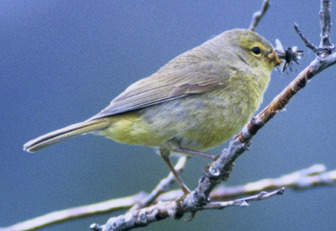Orange-crowned Warbler
The Orange-crowned Warbler is a small songbird of the New World warbler family.

The Orange-crowned Warbler is classified as Least Concern. Does not qualify for a more at risk category. Widespread and abundant taxa are included in this category.
The Orange-crowned Warbler (Vermivora celata) is a small songbird of the New World warbler family. These birds are distinguished by their lack of wing bars, streaking on the underparts, strong face marking or bright colouring, resembling a fall Tennessee Warbler. The orange patch on the crown is usually not visible. They have olive-grey upperparts, yellowish underparts with faint streaking and a thin pointed bill. They have a faint line over their eyes and a faint broken eye ring. More
Orange-crowned Warbler is common and widespread in the West, but is much less common in most of the East. It can be one of the most numerous migrant warblers in the western and central United States, but its numbers decrease to the east. More
* Orange-crowned Warbler Species Account - Cornell Lab of Ornithology * Orange-crowned Warbler Information and Photos - South Dakota Birds and Birding * Orange-crowned Warbler - Vermivora celata - USGS Patuxent Bird Identification InfoCenter This entry is from Wikipedia, the leading user-contributed encyclopedia. More
where orange-crowned warblers haven't been spotted in one season or another. Orange-crowned warblers are typically found in shrubby habitats, whether it be the bogs of Alaska or the chaparral of California, and make a living gleaning insects off leaves. Identification is not particularly easy. The species resembles the Tennessee warbler (V. peregrina) and, with generally drab and geographically variable plumage, lacks clearly identifiable field markings. More
* The Orange-crowned Warbler is divided into four subspecies that differ in plumage color, size, and molt patterns. * The boreal-nesting form has one of the latest fall migrations of any warbler, not leaving its Canadian breeding grounds until late September or October. More
In voice and plumage, Orange-crowned Warblers are very plain birds More
The outlook for orange-crowned warblers is uncertain there, but it is possible that the dense regenerating vegetation is to their liking. The most promising field sites contain hackberry trees and live oaks growing on the remains of old sand dunes. This habitat is very important for migratory birds as it is the last stop before migrating over the open expanse of the Gulf of Mexico. It is also ideal wintering habitat for orange-crowned warblers. More
Behavior: Orange-crowned Warblers often forage low in vegetation, but will forage at all heights. They clamber and flit through vegetation, gleaning insects from flowers, leaves, and tips of branches. They will also sometimes capture insects in flight. Nesting: Non-breeder in South Dakota Song: High thin trill, trailing downward in pitch at the end. Migration: Summers in Canada and the Rockies in the western U.S. Winters in the extreme southern U.S. and points south. More
Orange-crowned Warblers are commonly found in shrubby thickets and deciduous woodlands, especially those with aspen and willow. During migration, they are often found at higher elevations, in alder and mountain ash stands, or along lowland streams in red-osier dogwood and Himalayan blackberry thickets. Weedy fields with dense clumps of cover are important in migration and at wintering sites, and are their preferred habitat in fall and winter in eastern North America. More
total of 72,947 Orange-crowned Warblers have been banded since 1955. Of these, only 79 have been recovered. This is a recovery rate of 0.108%. Conservation Status Orange-crowned Warblers perform an important role in our ecosystem by gleaning insects from leaves and foliage. They also eat spiders and berries, and sometimes visit bird feeders. Annual Breeding Bird Census data indicates that populations of Orange-crowned Warblers are increasing in some areas in the west, but declining in others. More
30 décembre 2008 — Adult orange-crowned warbler feeding nestlings on the Channel Islands, California. More
A Closer Look at the Dusky Orange-crowned Warbler Nests of Santa Catalina Island - small yellow bird The dusky orange-crowned warblers (Vermivora celata sordida) found on Santa Catalina Island, California are a little different than their brethren. Most orange-crowned warblers build their nests on or close to the ground. But not the dusky orange-crowned warbler. More
Despite its lack of showy plumage, the orange-crowned warbler is a fascinating bird to study. It is one of the most widely distributed warblers in North America, able to inhabit conditions as diverse as the arid, Mediterranean climate of southern California and the sub-arctic, highly seasonal environment of Alaska and northern Canada. It also exhibits diverse migratory strategies. More
The Orange-crowned Warbler has been the subject of extensive studies of its molt, pterylography, and ecto-parasitism (Foster 1967a, b; 1969). Much past information on the species’ ecology, behavior, and breeding, however, has been anecdotal. Within the past two decades more comprehensive studies have been made, especially of V. c. lutescens in Contra Costa Co., central California (Gilbert 1986, 1994, WMG), V. c. orestera on the Mogollon Rim in central Arizona (Zyskowski 1993, Martin and Martin 2001a, b; Martin 2007), and of V. c. More
Orange-crowned warblers are fairly common spring migrants and very common fall migrants, a big pulse usually comming through Oasis Valley in late August and September. They prefer cottonwoods and willows. ^A warbler picking at a gall. ^In a cottonwood. ^In a weedy Cleome plant. More

Original source: Greg7 on Flickr
Author: Greg7 on Flickr
Permission: Some rights reserved

